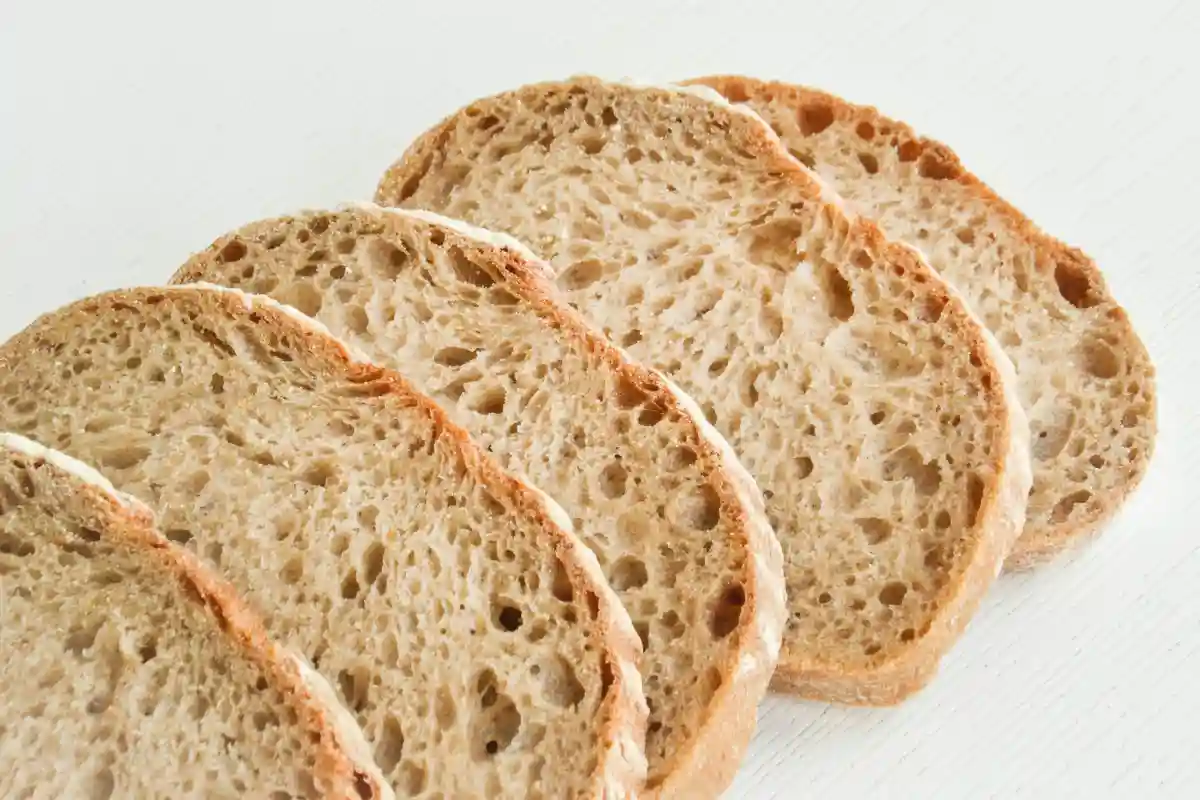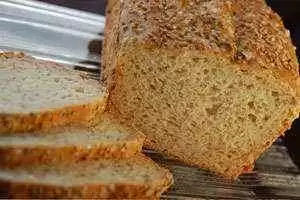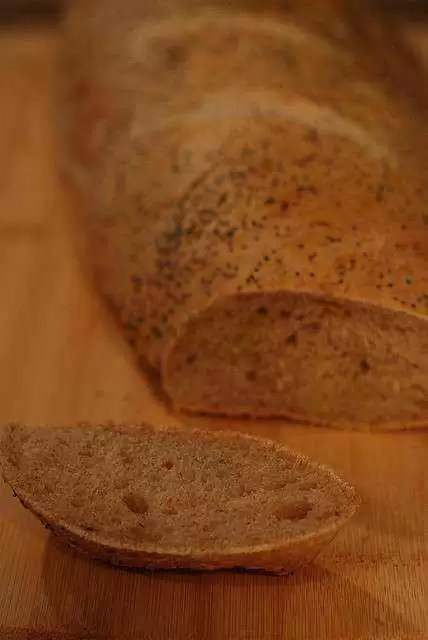-
Welcome to Celiac.com!
You have found your celiac tribe! Join us and ask questions in our forum, share your story, and connect with others.
-
Celiac.com Sponsor (A1):
Celiac.com Sponsor (A1-M):
-
Get Celiac.com Updates:Support Celiac.com!
Search the Community
Showing results for tags 'better'.
-

Researchers Seek the Holy Grail of Gluten-Free Bread
Jefferson Adams posted an article in Summer 2023 Issue
Celiac.com 06/13/2023 - While the development of gluten-free baked goods has improved in leaps and bounds over the years, food scientists are still hard at work to find an effective alternative to match the bread-friendly properties of gluten. In chemical-physical terms, gluten is a key protein in baking. It plays a crucial role in giving bread its desired texture and structure. However, for individuals with celiac disease or gluten intolerance, consuming gluten can have detrimental effects on their health. But everyone loves bread, so gluten-free bread has become big business, however no brand has yet found the Holy Grail that is a gluten-free bread which is indistinguishable from traditional bread. One of the problems is air. One of the ways to think of gluten is as a net that keeps dough airy until baking stabilizes the open-pore structure. This net is capable of trapping gas bubbles during fermentation; the stronger it is, the more gas it can hold, and the higher the dough can rise. What has been almost impossible to do so far is to keep the many small gas bubbles in the dough without the supporting gluten scaffold, said Prof Dr Mario Jekle, head of the Department of Plant-Based Foods at the University of Hohenheim in Stuttgart. At the same time, the more the gluten develops, the stronger and longer those interconnected strands become, leading to more chewiness and toughness in the final product. Hence the variation of flours for different applications. Although bread begins with many of the same ingredients as cakes, it has a completely different consistency. Bread flour has a protein percentage of 11%-13%, resulting in a product that is airy and satisfyingly chewy. It's hard to imagine enjoying a chewy cake, so cake flour, with a protein percentage of 7%-9%, has a low gluten-development potential. A common misconception is that gluten is part of flour. Yes, flour contains the two proteins - glutenin and gliadin - necessary to form gluten, but these only join to form that miraculous net when a liquid, like water or milk, is added. In gluten-free baking, lathering up ingredients–creating friction to trap air– isn't a problem. This can be achieved by stirring or using a leavening agent like yeast or baking powder. What gluten-free baked goods lack is the supporting network that holds it all together. However, gluten is a problematic protein for about 2%-3% of the global population. Kneading wheat bread dough. Image: CC0 1.0--rawpixel Gluten Means Disease and Discomfort for the Gluten Sensitive We now know three disease patterns that are related to gluten, said Prof Dr Stephan Bischoff of the Institute of Clinical Nutrition at the University of Hohenheim. The first is celiac disease, which is a widespread chronic autoimmune disease in which the body mistakenly reacts to gluten as if it were a poison. The second is wheat allergy, which is triggered by gluten and similar peptides and is similarly widespread. The third clinical picture is non-celiac gluten sensitivity, where essentially no antibodies are produced, and there does not appear to be damage to the gut lining. What triggers wheat sensitivity, and whether gluten also plays a role, is still unclear. According to Celiac UK, two further gluten-related disorders can be added to the mix. Gluten ataxia is one of a number of neurological manifestations of celiac disease, causing clumsiness, incoordination, slurred speech and sometimes jumpy vision. Another condition, dermatitis herpetiformis is the skin presentation of celiac disease, associated with small blisters on the elbows and knees. No matter the level of intensity, people who cannot stomach gluten have only one remedy in everyday life , which to eat only gluten-free foods. High Fiber from Plants The research team the University of Hohenheim are taking a new approach. Instead of supporting the dough with gluten, Bischoff's team is focused on stabilizing the interface between gas bubbles and dough with alternative proteins. The team is working on extracting protein from peas, rapeseed, rice and maize, that can directly replace gluten protein. Prof Dr Jekle also sees further potential in plant breeding. By precisely defining the optimal parameters to meet their needs, the team hopes to work with plant breeding, in order to target new pea varieties, whose proteins are even better suited to their approach. In another approach, the department is trying to link the natural proteins from rice, maize or oats with mucins (referred to as arabinoxylans) to form chains with gluten-like properties. The scientists also found that naturally-occurring compounds called sapponins found in the cells of quinoa seed or mucilages of cereal hulls–along with the stems, leaves and flowers of daisies–additionally support the formation of an airy dough. It is an approach with additional benefits as, in some cases, it can be used to enrich baked goods with valuable dietary fibre. For example, we know that 30g per day of fiber is already good prevention against colon cancer, one of the three most common cancers in men and women, said Prof Dr Bischoff. The scientists are planning to investigate the use of arabinoxylans in other applications, like meat substitutes. The approach not only gives plant-based products a meat-like structure but additional nutrition from the dietary fibre. So far, there are no comparable products on the market, claim the scientists. The bread rolls currently coming off the mini production line at the University's Technical Centre for Food Science are still small - each comprising 30g of dough, but after being steamed and then baked, the results are light, golden and steaming. The experiment, which uses a hand-width conveyor belt, combines technology with materials science and engineering. However, the challenge is to find the best recipe, as the dough is completely gluten-free, and needs to deliver a final product that is fluffy and tastes good. 3D Printed Bread The department is also working to loosen the dough and combine it with the baking process in one step with the help of 3D printers. A nozzle builds up the pastry together with the pores in millimetre-thin layers, above which, a baking unit immediately solidifies each layer. The process is somewhat similar to the way Salzwedel bakers have been baking the classic Baumkuchen (literally translated 2019) for 200 years. Using a ladle, the Baumkuchen batter is applied in millimetre-thin layers onto a rotating roller and baked layer by layer in front of an open flame. The technology at the University of Hohenheim is, of course, much more sophisticated, flexible and can build many different structures, according to Prof Dr Jekle. His team has been experimenting with 3D printing for several years and in principle, almost any food–from bread to meat to plant-based products, can be produced by this piece of equipment. 3D printing also has advantages that extend from personalized nutrition to sustainability and limiting food waste. With printed foods, we can personalize meals, meaning we can tailor the ratio of fats, carbohydrates, proteins and all other components to exactly meet the personal needs of individuals, said Prof Dr Jekle. And I can also obtain some of the raw materials from residual materials that are created during food production, for example. Read more at bakeryandsnacks.com- 4 comments
-
Celiac.com 07/25/2012 - While a great deal of progress has been made with gluten-free food over the last ten years, many celiacs still feel that they are 'missing out' on gluten-containing foods. Fadi Aramouni, professor of food science at Kansas State University is working to change this through extensive research and testing on sorghum, as well as other wheat alternatives. Sorghum is an appealing alternative to wheat because it is already widely produced in the United States (it is primarily used as feed). The problem is that sorghum is different from wheat, and requires different processing methods to yield food products that are comparable to their wheat counterparts. Aramouni and his team of students and researchers began their search for a non-gluten wheat substitute by carefully inspecting the six varieties of sorghum that are grown in Kansas. Qualities such as grain hardness, dough quality, stretching and rolling qualities, protein, carbohydrates and fiber content as well as taste and look of the finished product were all considered. According to Aramouni, this stage of their research yielded an important discovery: the milling stage dramatically alters the properties of sorghum flour. Different particle sizes yield different results, so the consistency and taste of sorghum-based foods can be modulated before they are even prepared or cooked. In addition to the taste and consistency, Aramouni's team also found that particle size alters sorghum's glycemic index, so it is possible that a very specific milling practice could make products healthier, perhaps even compared to other gluten-free wheat alternatives like corn and rice. Along with the grain science and industry department at Kansas State University and the U.S. Department of Agriculture laboratory in Manhattan, Kansas, Aramouni and his team have developed a variety of sorghum-based tortillas, waffle ice cream cones, breads and Belgian waffles. Time and many taste tests will tell whether Aramouni's research will pay off in the form of more appetizing gluten-free products, but at the very least he and his team are helping us understand that is not just about what grains you use, but how they are processed. Source: http://www.newswise.com/articles/research-with-gluten-alternatives-shows-promise-for-kansas-sorghum-farmers-and-consumers
-
Celiac.com 02/25/2021 - Numerous starch-based gluten-free breads are made with corn, potato starch and hydrocolloids, all of which are low in nutrients and devoid of health promoting compounds. These types of bread have some advantages. They are often shelf stable, and/or frozen. However, their poor nutritional qualities makes them less appealing to many consumers. One solution is to supplement such breads with pseudo-cereals, seeds, fruits and/or vegetables rich in nutritional components, especially antioxidants. Pulp from red fleshed (Magenta Love) and purple fleshed (Violetta) potatoes is high in dietary fiber, along with endogenous polyphenols, namely flavonoids, flavonols, phenolic acids and anthocyanins with high antioxidant potential. Because of these nutritional qualities, these potatoes offer tremendous potential for cheaply and easily fortifying starch-based gluten-free breads made with corn, potato starch and hydrocolloids. Recently, scientists at the University of Agriculture in Krakow (Poland) assessed the effects of various levels of freeze-dried pulp from red and purple potatoes on polyphenol, fiber, antioxidant and acrylamide content in the analyzed gluten-free breads containing the above potato pulp. They found that pulp from colored flesh potatoes is rich in pro-health compounds, especially fiber and polyphenols. The pulp can be used to fortify gluten-free bread with phenolic compounds and fiber, without reducing favorable properties, such as crumb elasticity, porosity, taste and smell. Gluten-free bread fortified with 7.5% freeze-dried Magenta Love red potato pulp was high in phenolic compounds, dietary fiber, and antioxidant activity, coupled with low levels of potentially dangerous acrylamide and good physical and sensory qualities. Their team recommends that manufacturers consider using the 7.5% mix for large scale gluten-free bread production. Since nutritional deficiencies are common in people with celiac disease, improving the nutritional profile of gluten-free breads that are typically made with corn, potato starch and hydrocolloids would be beneficial to numerous people. Read more in PLoSONE 15(9):e0229841.
- 2 comments
-
- better
- gluten-free bread
-
(and 3 more)
Tagged with:
-

7 Easy Tips for Baking Better Gluten-Free Bread
Jules Shepard posted an article in Gluten-Free Cooking
Correctly measure your flour. When measuring flour, don’t scoop from the bag with your measuring cup. This compresses the flour. Use a spoon to scoop flour into the measuring cup and level off with a knife. This will ensure that your flour is measured properly. Bring your ingredients to room temperature before mixing. It is particularly important for yeast recipes to bring all of your ingredients, such as eggs, to room temperature before adding them together to make bread. Yeast needs warmth to grow and if your ingredients are too cold, it may prevent full yeast growth. Make sure your loaf of bread is actually fully cooked. It is very important not to take your bread out of the oven before it is fully cooked. If the bread has a rubbery layer at the bottom, this usually means it was not fully cooked. The best way to tell if the bread is done is to take a baking thermometer and insert it all the way into the bottom of the loaf. The temperature should be approximately 210 F when it is done. Your bread will keep its shape better overcooked than undercooked, so if in doubt, keep it in the oven a bit longer! My recipes have plenty of moisture, so you shouldn’t worry too much about the bread drying out. If baking by oven method, use metal pans. I have found that glass bread pans do not work as well as metal pans in fully cooking a loaf of bread. Metal pans do not have to be fancy or expensive, and you can often even find them in your local grocery store. Rising issues. A great method for letting your yeast breads rise before baking is to turn on your oven to 200F, then turn it off when it has reached temperature. Put your un-raised bread into the warmed oven with an oiled piece of wax paper on top and let it rise according to directions. Once raised, removed the wax paper and bake according to directions. How to prevent your bread from sinking. When your bread is done cooking, turn off the oven and open the door so that the bread can cool slowly. Taking the bread out of a hot oven and quickly transferring it to a cool counter can sometimes cause the loaf to sink in. If it still sinks, it may have too much moisture in it to support itself fully. It should still taste great, but if you have your heart set on a nice crowned loaf, next time try cutting back on the liquid a bit in that recipe or adding ¼ cup of flaxseed meal to help support the bread's structure and enhance its nutritional value, all in one! Altitude and even the day's weather can affect sometimes picky yeast recipes. How to make a multi-grain loaf of bread. To make a more “whole grain” bread, take a basic recipe (for example, Jules’ Sandwich Bread recipe). In place of the 2 cups of Jules Gluten Free All Purpose flour, add only 1 ¾ cups. Replace the final ¼ cup with flax seed meal, buckwheat flour, gluten-free oat flour, brown rice flour, or teff flour. These flours will add more whole grain flavor and additional fiber. You can also add seeds (flax seeds, sesame seeds, etc.) to add crunch and fiber. With this amount of different flours, you do not need to adjust the recipe at all. -
Celiac.com 02/26/2018 - People with celiac disease and gluten-sensitivities react adversely to gluten proteins in wheat, barley and rye. The gold standard for assessing gluten levels in foods is a test called the enzyme-linked immunosorbent assay, aka ELISA. Now, ELISA is, by most measures, a good test. However, it does have some drawbacks. ELISA tests do vary by manufacturer, and can provide inconsistent results, including false negatives, which can be harmful for people with celiac disease or gluten-sensitivity. Also, for optimal detection, each type of gluten requires a different ELISA. So, barley, wheat and rye all require separate tests. Researchers Kevin D. Dorfman, Scott P. White and C. Daniel Frisbie claim they have developed a gluten detector that can rapidly detect and quantify different sources of gluten with a single test. Their team says that their gluten assay device is based on floating gate transistor technology, and relies on tiny micro-channels for a sample to move through. Gluten in a sample will bind to one of three capture agents, which can be antibodies or a DNA-based aptamer, that specifically latch onto gluten proteins from certain sources. This binding causes a shift in the voltage read-out of the transistor which acts as a chemical fingerprint that identifies the gluten as being from barley, wheat, or rye. As with ELISA, the device could detect gluten below 20 parts per million, which is the maximum threshold allowed by the U.S. Food and Drug Administration for a "gluten-free" label. Because it has fewer processing steps, and uses automated sampling, the new sensor typically produces results 45 minutes faster due than ELISA tests. The new test is still in development, and not set to replace ELISA anytime soon. But progress in the gluten-free world is rapid these days, so changes to commercial gluten detection systems are likely on the near future. Source: American Chemical Society
-
Celiac.com 09/08/2016 - I'm going to discuss a topic that I'm sure will be fraught with controversy. However, as someone who has watched the difficulty that so many new patients have in navigating their diets on gluten-free and celiac forums for the past twelve years, I believe it's time to consider a new model for approaching the gluten-free diet. A gluten-free diet is essential to the celiac patient, but it disrupts the metabolism in profound ways that, until now, we have ignored because there is absolutely no other option for those of us who can't digest gluten. It is worth noting that there are other situations where we may find ourselves drastically reducing carbohydrates in order to realize health benefits. (Bear with me here, I'm going to tie it all together soon!) Changing the diet to limit or eliminate one's intake of grains and starch is a common response to many of the following situations: People who have celiac disease, non-celiac gluten sensitivity or wheat allergy. Diabetics who seek to stabilize blood sugar. People with small intestinal bacterial overgrowth (SIBO) who need to limit all di- and polysaccharides (most starches and sugars) per the SCD or GAPS diets. People on the FODMAP (Fermentable Oligosaccharides, Disaccharides, Monosaccharides And Polyols) diet for fructose, lactose and fructans intolerance. Many celiac patients report benefits of this diet when symptoms don't resolve after treating celiac disease. People starting the Paleo diet or the autoimmune protocol diet (AIP) are instructed to stop eating grains and processed foods. People eating a very low-carb diet (below 40 grams per day) in an effort to shed excess body weight. People with epilepsy and certain other neurological disturbances who benefit from a reduction in carbohydrates in order to promote ketosis (see Gut and Psychology Syndrome diet, or "GAPS diet"). People who are fighting metabolic syndrome and insulin resistance. The thing that all these situations have in common is the need to make a significant dietary reduction of grains and starch. While the standard American diet consists of 300-400 or more grams of carbs a day, some diets restrict carb intake to less than 20-40 grams. A significant carb reduction of any kind can cause a huge strain on our well-being by causing a dip in thyroid function. Paleo diet authors generally recommend a maximum of 100-150 grams of carbs in order to stabilize blood sugar, a decrease in carbs of at least 50% for most people. Even those of us who are merely cutting out gluten because of a celiac diagnosis can have a very difficult time adjusting to the new diet. Unfortunately, little is mentioned about the down side of making such a huge, if necessary, change in eating habits. About a third of us feel so lousy after cutting down on our carbohydrate intake that we seriously consider turning our backs on our new diets. The strain of staying on track can be overwhelming. Twelve years ago, as a newly-diagnosed celiac patient, I experienced sleep disturbances, anxiety so high I couldn't relax, hyper-vigilance, an absolutely crushing brain-fog as well as general malaise. I had been sent out into the world beyond my doctor's office with no more than a celiac disease diagnosis and the advice that I now need to stop eating gluten. And stop I did. I had been ill for so long prior to my diagnosis that I would have given up all food if I thought it would make me feel better. I was so distrustful of every processed food I had grown accustomed to that for the first two weeks I ate little more than broiled chicken breasts, steamed broccoli and rice. The whole process of shopping, cooking and eating sometimes became psychologically overwhelming. I was afraid I'd starve to death if I left the house for more than half an hour so I always kept a gluten-free protein bar in my purse to prevent all-out panic. There may be more than one process at work here. Why do I feel so awful? A couple of small studies point to a problem low-carbers have in maintaining production and uptake of the thyroid hormone triiodothyronine (often referred to as T3). T3 is the most active form of thyroid hormone. Every cell in the body needs it for oxygen uptake. A sudden reduction in carbohydrate intake can lead to a dip in T3 availability that can lead to cognitive problems, depression, anxiety, fatigue, weight gain, constipation, heart palpitations and a laundry list of other hypothyroidism related symptoms and complications. Although this can happen to anyone reducing carbohydrates, most people will eventually bounce back if they are getting over 100 grams of carbs a day. However, for those very-low carbers who stay under 20 daily grams, they can expect to deal with a sluggish thyroid until their carb intake increases to maintenance levels. Gluten Withdrawal is Real It also appears that some of us are quite sensitive to the opioids in the grains we most commonly eat. Every grain has it's own opioid, but they differ from each other. Even cutting out wheat or gluten while maintaining a high carb intake can give us symptoms that mirror drug withdrawal, so obviously, it's not just about carb reduction. Although the amount of opioids in wheat is quite small, we all have opioid receptors in our brains that have the potential to become quite dependent on our little wheat-driven drug rush. I think anyone who has quelled their hunger or anxiety with a piece of bread and butter and felt that "ahhhhhh" response can relate. The enormous (if temporary) sense of satisfaction that comes with sitting down to a bowl of pasta may be due to the presence of the opioids in the semolina wheat grains that were used to make that delicious fettucine alfredo. "Gluten withdrawal," has a real biochemical basis; you wouldn't expect someone to kick Ativan or Vicodin in one fell swoop. In fact, it's downright dangerous. Perhaps we shouldn't be asking it of people who must give up their usual grains. People who kick an addictive drug have been helped mightily by the use of a drug called "low-dose naltrexone (LDN). It has been suggested that, by the same mechanism, it can prevent some of the problems created by the discontinuation of grains. I, for one, would love to see some research on this. Most Americans are familiar with the concept of filling up on a Chinese buffet only to feel hungry ten minutes later. Most Asian recipes use rice as a base of the main dish, so we are getting plenty of carbs. But why do we still feel hungry soon afterward even though our belts are still too tight? I remember back when my family lived in a great little neighborhood in Pennsylvania. Norristown, like most Philadelphia suburbs, was comprised of small storefronts and lots of nearly identical, charming brick row houses. We lived in a cute little twin number next door to a big Asian family with whom we soon became acquainted. One of the kids brought over a very generous house-warming gift of wonton soup. The first time I slurped from Ahn Nguyen's golden liquid luxury, replete with beautifully folded floating dumplings, I thought I'd died and gone to heaven. She sent many delicious treats over during the time we lived next to them and I can't think of those wonderful dishes these many years later without my mouth watering. Although it couldn't come close, I tried to pay some of our debt to them by inviting the family of seven over to a big dinner of spaghetti, meatballs (complete with homemade marinara), fresh grated Parmesan and garlic bread and a big green salad (obviously, this was a time previous to my celiac diagnosis.) Ahn and her family all seemed to enjoy the meal, but she confessed to me afterward that she needed to go home for a bowl of rice in order to feel full. This after she had eaten two big plates of spaghetti! Clearly, her discomfort wasn't a matter of getting enough starch. My best guess is that she missed the specific opioids in rice that she had likely consumed at every meal. I can't help but wonder now whether some Tinkyada rice pasta would have done the trick for her. Perhaps the opioids in the wheat-based food helped somewhat but they just couldn't satisfy her craving for that tiny amount of rice opioid; that narcotic-like substance on which her brain and body had come to depend. The Role of Ketones Another possible mechanism at work might be the unusual difficulty that some people have in converting fatty acids into ketones. When human beings don't have enough sugar or starch available from our diet to convert into glucose, we really feel it in fatigue and mental sluggishness. We may become uncommonly irritable as well. Luckily, our bodies have the marvelous adaptive ability to convert fatty acids to ketone bodies. These ketone bodies may be converted from either dietary fatty acids or from our own fat stores. Ketones are the only known source outside of glucose that lend energy to our brains and bodies. Unfortunately, about 14% of the population (including me) has an APOe4 gene variant that makes our livers less efficient at getting energy from fat; we have a harder time producing ketone bodies than everyone else when our glucose stores suddenly plummet. Note that this gene is also associated with a marked increase in the risk of Alzheimer's disease. Some researchers believe that this is due to the difficulty in making ketones, which may protect the brain from insulin resistance. For those of us with APOe4, it may just be that much more difficult to achieve a fat-adapted state that will allow the production of ketone bodies. Those of us with APOe4 and everyone who has a harder time going low-carb may just need a little more time in the adaptation process to get our livers to change their stubborn ways. It can't be healthy, while waiting for ketones to kick in, for our brains and bodies to be starved of energy. Is it possible that there is one answer to all of these problems? Could a much more gradual transition from high carb to low carb or gluten-free put less strain on body systems? I propose that we examine the possibility that cold turkey isn't the best way to cut back on either gluten or carbs. What evidence do we have that the best way is the hard way? Yes, for some of us, wheat or gluten is absolute poison and we want to be rid of it as soon as possible. But will taking a week or two to wean off of it really have any lasting negative impact on our overall health? For those who don't have severe digestive symptoms at the point of a celiac or NCGS diagnosis, a strategy of careful withdrawal should be considered. So, let's say you have just been diagnosed with celiac disease. Or diabetes, or metabolic syndrome, or hypoglycemia or SIBO, or epilepsy or you simply want to drop excess weight on the Atkins diet. You've been told, or have figured out on your own, that cutting down on carbs or cutting out gluten is your next step back to health. How do you go about it? Should you simply throw out all the crackers? Toss all your mixes, breads, flours and pastas? File all your cupcakes, cookies and brownies to the round file? Well, yes and no. Get rid of everything but your last loaf of bread and put that in the freezer. It will help to get those slices apart later if you can stagger the slices inside the wrapper or even put a square of wax paper between them. This also works well for people on a gluten free diet who are cutting carbs. In that case, use gluten-free bread. If you feel significant distress when cutting carbs or grains, let your head tell you when to eat that slice of bread. When you get dizzy, foggy and irritable, that's the time. Just try to spread them apart as much as possible without suffering overly for it. Trust me on this, in a couple of weeks it will all be over! Those who don't experience discomfort may still benefit by following this guideline: Days 1-3: two slices of bread maximum Days 4-6: one slice of bread daily; you may want to eat 1/2 slice twice a day Days 7-14: 1/2 slice of bread per day, maximum After day 14, quit eating it altogether When it's time to have your slice of bread, take a piece out of the freezer, put it in the toaster or thaw it in the microwave for 10 seconds and eat it with a big slab of good butter. Kerry Gold is my favorite butter. It's from grass-fed cows so it has lots of healthy omega-3 fatty acids. If this is your last loaf of real bread, you might as well make it count! Consider this as the long goodbye and the first step in the mourning process. Spread those slices out for as long as you can stand it, but don't let yourself suffer for long. Pretty soon, one slice a day will keep all those annoying withdrawal symptoms completely at bay. After that point, you only need to eat a half a slice at a time. You may soon go a day or two without noticing any problems; at that point, you're home free, and you need never eat it again. Throw the rest out or leave it out for your family, if you have an gluten-eaters in the household. Clearly, this whole subject needs a lot more research. I'd like to see more study on exactly what happens to thyroid levels during carb restriction. I'd like to know what it does to our blood sugar, our livers and our brains when we make huge lifestyle changes such as these. I'd like to know how we vary in our ability to produce ketones and how many of us function optimally on ketones in the absence of glucose. We should also know what happens to our microbiome, the bacterial colony that lives mainly in our guts when we change our diets. I think we are just now scratching the surface in learning how food interacts with our bodies. Yes, there is a lot to learn and some are making strides in discovering how food helps and hurts our health. In the meantime, we are wise to tread carefully, even when making a necessary lifestyle upgrade. References: Decline in T3 after low carb diet: Ullrich IH, Peters PJ, Albrink MJ. Journal of the American College of Nutrition [1985, 4(4):451-459] GAPS diet: http://www.gapsdiet.com/ FODMAPS diet: http://stanfordhospital.org/digestivehealth/nutrition/DH-Low-FODMAP-Diet-Handout.pdf Atkins diet: http://www.atkins.com/Home.aspx Paleo diet: http://robbwolf.com/what-is-the-paleo-diet/
-
Celiac.com 11/11/2016 - Do allergen advisory statements for wheat help US consumers with celiac disease make safe food choices? A team of researchers recently set out to review food that were not labeled gluten-free, but which appeared to be free of gluten ingredients based the ingredients list. The product labels indicated that the products contained no wheat, barley, rye, malt, brewers yeast. The research team included T. Thompson, TB Lyons, and A Jones. They are variously affiliated with Gluten Free Watchdog, Manchester, MA, USA; the Department of Clinical Nutrition, MetroHealth Medical Center, Cleveland, OH, USA, and with Mary Rutan Hospital Nutrition, Bellefontaine, OH, USA. Looking for allergen advisory statements noting wheat, gluten or both, the team retrospectively reviewed labeling information for 101 products tested for gluten content. They tested products through the gluten test reporting service Gluten Free Watchdog, LLC in Manchester, MA, USA. The review included all commercially available products tested by Gluten Free Watchdog not labeled gluten-free or low gluten at the time of this analysis. Gluten testing was conducted via Bia Diagnostics in Burlington, VT, USA. Each product sample was tested in duplicate using the Ridascreen Gliadin sandwich R5 enzyme-linked immunosorbent assay (ELISA) Mendez method (Ridascreen Gliadin R7001) and extracted with the cocktail solution (Art. No. R7006—official Mendez method) following the kit manufacturer’s directions (R-biopharm, Darmstadt, Germany). Seven of the 14 foods with quantifiable gluten in this assessment are single-ingredient foods, such as oat fiber, spices, and green tea leaves. Many single-ingredient foods are considered by consumers to be naturally gluten-free. However, US grain standards allow certain percentages of foreign material in grains, seeds and legumes. On the basis of this analysis, the current use of allergen advisory statements for wheat or gluten are not useful predictors of whether or not a single or multi-ingredient food product contains 20 or more p.p.m. of gluten. The authors are urging the regulation and standardization of such precautionary statements so that they are helpful to gluten-free consumers. Source: Eur J Clin Nutr. 2016 Sep 14. doi: 10.1038/ejcn.2016.155.
-
Celiac.com 12/15/2016 - Celiac disease and irritable bowel syndrome (IBS) can have similar symptoms, and confusion between the two can often cause delays in diagnosis. International guidelines recommend screening IBS patients for celiac disease using serological testing. However, studies published recently have cast doubt on the utility of this. A team of researchers recently set out to assess the use of serological testing to screen IBS patients for celiac disease, and to update a previous meta-analysis of this issue. The research team included Andrew J Irvine, William D Chey and Alexander C Ford. They searched MEDLINE, EMBASE, and EMBASE Classic through May 2016, looking for studies that had recruited adults with IBS according to symptom-based criteria, physician's opinion, or questionnaire data. Tests for celiac disease included IgA-class antigliadin antibodies (AGA), endomysial antibodies (EMA), tissue transglutaminase antibodies (tTG), or duodenal biopsies following positive serology. They combined the proportion of individuals meeting criteria for IBS, and testing positive for celiac disease, to give a pooled prevalence for all studies, and they then compared between cases with IBS and, where reported, healthy controls without IBS, using an odds ratio (OR) with a 95% confidence interval (CI). They found a total of thirty-six eligible studies, and 15,256 participants, nearly sixty-one percent of whom met criteria for IBS. Pooled ORs for positive IgA AGAs, EMA and/or tTG, and biopsy-proven celiac disease in IBS subjects vs. controls were 3.21 (95% CI 1.55–6.65), 2.75 (95% CI 1.35–5.61), and 4.48 (95% CI 2.33–8.60), respectively. The authors wrote that there was "no increase in ORs for any test for celiac disease among cases with IBS in North American studies, and results were inconsistent in population-based studies." Rates of biopsy-proven celiac disease were substantially higher across all subtypes of IBS. Their review had a few limitations, including heterogeneity in some analyses, along with limited North American study data. Overall, people with symptoms suggestive of IBS had higher rates of positive celiac serology and biopsy-proven celiac disease than did healthy control subjects. However, the case for celiac disease screening for individuals with suspected IBS in North America is still unclear. Essentially, we need broader and more comprehensive study of this issue in North America. Source: The American Journal of Gastroenterology, 18 October 2016. doi:10.1038/ajg.2016.466
-

Starbucks Looks to Add Better Gluten-free Options
Jefferson Adams posted an article in Additional Concerns
Celiac.com 09/27/2016 - After repeated shareholder requests, and a public admission from the CEO that the company had "really screwed up the gluten free stuff," Starbucks is announcing an expansion gluten-free and other specialty options. Until now, Starbucks has relied heavily on packaged foods to meet the rising demand for gluten-free food raises. As part of a new effort to change that, the company recently released its latest offering, the organic gluten-free, vegan, kosher chickpea puff called Hippeas, which is currently available in white cheddar and fajita flavors. Over the years, numerous shareholders have demanded that Starbucks CEO Howard Schultz add more food options for people who are either allergic to gluten or choose to eat gluten-free. At the 2015 shareholder meeting, Schultz said the company had plans to address the gluten-free issue because it represents a "big opportunity." He added that, to that point, the company had "really screwed up the gluten free stuff." Some gluten-free options are available regionally at various Starbucks, such as the Marshmallow Dream bar and the Kind Bars, but there has been little in the way of quality gluten-free options that are local, aritisanal, etc. "Items in our pastry case can be subject to cross contamination and we use shared equipment," Starbucks spokeswoman Erin Schaeffer said in an email response to questions. "So adding gluten-free options to our broader food portfolio has posed a challenge that we continue to explore." The market for packaged gluten-free foods is estimated at more than $3 billion and is continuing to grow. Last year, Starbucks launched the Retail Brand Partnership team, which is tasked with finding packaged goods that satisfy various dietary specialty needs. Read more in Bizjournals.com. -

Can Aptamers Give Us Better, Faster Gluten Detection?
Jefferson Adams posted an article in Latest Research
Celiac.com 07/04/2016 - The fast rising number of people diagnosed with celiac disease creates challenges to both the food industry and public officials to guarantee safe food. A great deal of effort is going into determining minimal celiac disease-eliciting doses of gluten and to refine and improve gluten-free labeling. A team of researchers recently set out to assess the harnessing of aptamers to overcome challenges in gluten detection. The research team included Rebeca Miranda-Castro, Noemí de-los-Santos-Álvarez, Arturo J. Miranda-Ordieres and María Jesús Lobo-Castañón of the Departamento de Química-Física y Analítica, Universidad de Oviedo in Oviedo, Spain. Their efforts rely largely on the ability to detect gluten protein in food samples at the lowest levels possible. Current analytical devices use antibodies to determine gluten protein levels. These devices have limited sensitivity, and also have some issues with the accuracy and reliability. Aptamers provide an ideal alternative for designing biosensors that can quickly and reliably measure gluten in foods. The team's article highlights the challenges in gluten detection, the current status of the use of aptamers for solving this problem, and what remains to be done to move these systems into commercial applications. They conclude: "The new receptors present high affinity and binding selectivity. In addition, they can be easily labeled with different reporter molecules at a relatively low production cost. These attributes make aptamers ideal reagents for the development of chemical sensors and analytical assays...Although still in its infancy, this sensitive technology will undoubtedly continue to advance." Source: Biosensors 2016, 6(2), 16; doi:10.3390/bios6020016 -

Can Better Tax Rules Help Promote Gluten-free Diet for Celiacs?
Jefferson Adams posted an article in Tax Deductions
Celiac.com 02/23/2016 - An estimated 350,000 Canadians have been diagnosed with celiac disease. For these people following a strict gluten-free diet is essential, not only for gut healing and symptom relief, but to avoid celiac-related complications such as anemia, osteoporotic fractures and small bowel lymphoma. However, a gluten-free diet can be challenging to follow, inconvenient and expensive. To help reduce costs and make things easier for celiacs, authorities have tried various schemes, including tax reduction, cash transfer, food provision, prescription and subsidies. But what works best? A team of researchers recently assessed the tax-deductible provisions for a gluten-free diet in Canada compared it with other countries. The research team included MI Pinto-Sanchez, EF Verdu, MC Gordillo, JC Bai, S Birch, P Moayyedi, and P Bercik. Their recent review highlights advantages and disadvantages in relation to promoting compliance with a gluten-free diet. The tax offset system used in Canada for gluten-free diet coverage takes the form of a reimbursement for prior food costs. Hence, the program does not help celiac patients reduce the costs of gluten-free foods, it just provides a later refund of a portion of those costs. In the research team's view, the best approach would lie in subsidizing gluten-free products through controlled vouchers or direct food provision to those who most need it, independent of 'ability or willingness to pay'. Moreover, they suggest, if such a program is too costly, the value of the benefits could be made taxable to ensure that any patient contribution, in terms of additional taxation, is directly tied to the ability to pay. The team says the limited coverage of Canadians' gluten-free diets is concerning, and suggest that there is a substantial unmet need for gluten-free dietary resources among celiac patients in Canada. Ultimately the team recommends that the Canadian medical community and the Canadian Celiac Association take a larger role in promoting improved access to gluten-free resources for people with celiac disease. Source: Can J Gastroenterol Hepatol. 2015 Mar;29(2):104-10. -
Celiac.com 10/01/2015 - Nutrilac protein from Arla Food Ingredients (AFI) offers manufacturers a way to make gluten-free products that are indistinguishable from products made with conventional flour, says John Kjaer, global sales manager for bakery at AFI. Kjaer points out that the gluten-free trend is huge right now, will only be sustainable if "bakery companies…can make gluten-free bread and cakes that are virtually indistinguishable from their conventional equivalents." According to AFI, Nutrilac can be incorporated into standard gluten-free baked goods, and offers gluten-free bakers a similar baking quality to wheat flour, producing an elastic dough that can be handled like standard wheat flour dough. This eliminates the problem of dry, crumbly gluten-free baked goods. Nutrilac uses completely natural milk proteins, which have a neutral, well-rounded milky taste, with no impact on overall product flavor. Products made with Nutrilac do not require new machinery or a change in standard manufacturing procedures, making it easier for companies to enter the gluten-free market, AFI said. AFI will be showcasing Nutrilac at IBA in Munich from the 12-17 September 2015.
-
Celiac.com 09/28/2015 - The Irish Daily Star is reporting that more than two dozen inmates at the country's top security Portlaoise Prison are set to protest prison authorities' refusal to give them gluten-free bread and better food. The inmates, including RIRA boss Michael McKevitt, say prison officials have broken an agreement to supply gluten-free bread as part of the prison diet. The availability of gluten-free bread seems to be an issue in what sounds like a larger complaint about the quality of food at the prison. Prisoners can purchase better food at the prison shop, at what prisoners claim are astronomical prices. According to the Daily Star, prisoners have begun stockpiling rubbish in preparation for a "dirty protest" in a bid to get the authorities to change their mind. The Prison Services have declined to comment. There has been no word about a direct connection to celiac disease in regards to the prisoners' demand for gluten-free bread. Earlier this week, republican prisoners group Cogus issued a statement highlighted food as one of the prisoners' main complaints. While that particular statement made no mention of gluten free bread, it read in part: "The food has seriously deteriorated over the last number of months and in general is sub-standard, at times unfit for human consumption, comprising of basic small portions which are totally inadequate." "This has resulted in men having to purchase food with the little money they have through the prison shop which charges extortionate prices. Numerous attempts have been made by the prisoners to resolve this issue but to no avail." Stay tuned for more developments. What do you think? Are prisoners entitled to gluten-free bread? Read more at: The Irish Daily Star
-
Celiac.com 03/27/2015 - Researchers don't have any solid idea about how common cases of seronegative celiac disease might be, but many feel strongly that rates of seronegative celiac disease are underestimated in children, and may result in misdiagnosis of celiac cases. One team of researchers wondered if an emphasis on "serology-led" diagnosis might be contributing to a low rate of celiac disease diagnosed in children from the United States. That research team included Deborah L. Preston and Yoram Elitsur, and they recently set out to investigate the rate of celiac disease after upper endoscopy (EGD) with no prior positive celiac serology compared with the rate of celiac disease followed by positive serology. The team conducted a retrospective review of that charts of all of the first diagnostic EGDs in children (2009–2013). They split the patients with confirmed celiac disease into 4 groups: group A, positive EGD/positive serology (histology-led diagnosis); group B, positive serology/positive histology (serology-led diagnosis); group C, positive histology followed by negative serology (control 1); and group D, positive serology followed by negative histology (control 2). The team reviewed a total of 761 upper endoscopic charts. They confirmed 15 children with celiac disease, for a rate of 1.97%. Group A and group B had similar demographic data or clinical symptoms, and similar rates of celiac disease between histology-led celiac diagnosis (group A) and serology-led celiac diagnosis (group (1.18% vs 0.79%, P = 0.273). This study showed that endoscopy-led diagnosis and serology-led diagnosis found celiac disease at similar rates. This finding suggests that better diagnosis of celiac disease in children requires performing an adequate number of intestinal biopsies in every diagnostic upper endoscopic procedure. Source: Journal of Pediatric Gastroenterology & Nutrition: March 2015 - Volume 60 - Issue 3 - p 357–359. doi: 10.1097/MPG.0000000000000602
-
Celiac.com 01/14/2015 - Recent epidemiological studies show that celiac disease rates are still underestimated, both in Europe and in Mediterranean regions. But how is better testing impacting higher celiac numbers in Europe? To get a clearer picture, a team of researchers recently set out to review the latest data on celiac rates and incidence in the European Union (EU) as of September 2014. The research team included E. Altobelli, R. Paduano, R. Petrocelli, and F. Di Orio. They are variously affiliated with the Department of Life, Health and Environmental Sciences at the University of L'Aquila in L'Aquila, Italy, and with ASREM in Molise, Italy. They assessed the celiac disease rates and cases by conducting a search of PubMed for papers in English using the key words "celiac disease", "celiac disease plus prevalence" (limits: 1990-2014), "incidence" (limits: 1970-2014), and "frequency", plus "in Europe". They conducted additional searches using the same key words plus the name of each European country. The team included only prevalence data obtained by serology using anti-gliadin antibodies (AGA), EMA test, tTG test, and/or duodenal biopsy, and only studies that were retrospective and prospective, such as population-based, cross-sectional, case-control and cohort studies. They found that the overall undiagnosed celiac population in EU is 0.5-1%, whereas the highest estimate reported in population-based studies is approximately 1%. Considering data from different periods, incidence seems to range from 0.1 to 3.7/1000 live births in the child population and from 1.3 to 39/100,000/year in the adult population. Interestingly, though perhaps unsurprisingly, the data show clear geographical variation in both cases and rates of celiac disease in various European countries. They note a rising occurrence of celiac disease in recent decades in European countries, due partly to the advent of improved serological testing (tTG + EMA) and partly to increased awareness of its clinical presentation. Source: Ann Ig. 2014 Nov-Dec;26(6):485-98. doi: 10.7416/ai.2014.2007.
-
This article originally appeared in the Autumn 2010 edition of Celiac.com's Journal of Gluten-Sensitivity. Celiac.com 12/06/2010 - The hazards to health created by celiac disease and gluten sensitivity are well understood. From nutritional deficiencies to osteoporosis, from depression to autoimmune disease, and from psoriasis to thyroid disease, there are few areas of the human body that gluten doesn’t touch in a negative way. There is so much emphasis on our inadequate abilities to diagnose gluten intolerance, that when we do finally make the diagnosis I believe we are guilty of another problem—lack of adequate education to those affected patients. Just last month a research study was released by the American Journal of Gastroenterology, 2010 Jun; 105(6):1412-20. The article was entitled “Mucosal recovery and mortality in adults with celiac disease after treatment with a gluten-free diet”. The research team hailed from the Division of Gastroenterology and Hepatology at Mayo Clinic College of Medicine. They stated that while a positive clinical response is typically observed in most adults with celiac disease after treatment with a gluten-free diet, the rate of small intestine recovery is less certain. Their aims were to estimate the rate of intestinal recovery after a gluten free diet in a cohort [a group of people with statistical similarities] of adults with celiac disease, and to assess the clinical implications of persistent intestinal damage after a gluten-free diet. Of 381 adults with biopsy-proven celiac disease, 241 had both a diagnostic and follow-up biopsy. Among these 241, the confirmed mucosal recovery at 2 years following diagnosis was 34% and at 5 years was 66%. Most patients (82%) had some positive clinical response to the gluten-free diet, but it did not prove a reliable marker of intestinal recovery. Poor compliance to the gluten-free diet, severe celiac disease as defined by diarrhea and weight loss, and total villous atrophy at diagnosis were strongly associated with persistent intestinal damage. There was a trend toward an association between mucosal recovery and a reduced rate of all-causes of death, adjusted for gender and age. The conclusions were that intestinal recovery was absent in a substantial portion of adults with celiac disease despite treatment with a gluten-free diet, and that there was an association between confirmed intestinal recovery (vs. persistent damage) and reduced mortality independent of age and gender. So what can we learn from this? Eating gluten-free when you are sensitive will cause you to feel better. Going on a gluten-free diet is not enough to ensure that your intestines will heal. Failing to heal your intestines puts you at increased risk for disease and death. Successfully healing your intestines reduces your incidence of death from disease. While you likely knew the first point, 2, 3, and 4 are perhaps less well known. Where I see that we are failing the gluten intolerant population is in the narrow focus of eliminating gluten as the only needed treatment. What the above research proves is that, unfortunately, for over 30% of those diagnosed simply eliminating gluten is insufficient to ensure intestinal healing. If patients were educated that healing their intestine would make the difference between contracting disease or not and extending their life expectancy or not, I think they’d be more interested in ensuring that it occurs. I am not a researcher but my clinic sees hundreds of patients who align with the results of this study completely. Patients come to see us who have been told that they shouldn’t consume gluten and for the most part they follow that recommendation. They know that they feel better when they are gluten-free so that is an impetus to not cheat. When they do cheat they know that they’ll “pay” for it but they still do so fairly regularly. Why do they cheat? Because they believe that the diarrhea, headache, bloating, etc is temporary and that when it goes away they are “fine” again. Their thought process is not unreasonable, it’s just wrong! If each patient was educated that cheating created intestinal destruction that in turn put them on a fast track towards disease and early death, I believe that cheating would take on a whole new perspective. Patients need this education and they need it often. Our book “The Gluten Effect” was written with this intention—our patients actually requested it. They asked for a written reminder of why they should maintain their gluten-free lifestyle. Later I began taping Youtube videos because other patients preferred a reminder in a video form. I’m trying to say this in a few different ways because it is terribly upsetting to meet patients, as I so often do, who have been diagnosed celiac or gluten sensitive and do not follow their diet solely due to ignorance. After almost 25 years of clinical experience I also know that some people “hear what they want to hear” and doctors with the best of intentions cannot get through to everyone. But I strongly believe that we could be doing a much better job at enlightenment. Further, we also need to educate patients about the secondary effects associated with gluten. When the immune system of the intestine is suppressed, as is the case in the presence of gluten pathology, inhospitable and pathogenic organisms can gain entry into the intestine and remain there. These organisms may be in the form of bacteria, parasites, amoebas or worms and if they are not identified and eradicated, complete healing of the intestines is all but impossible. The good bacteria that are housed in the gut, known as the microbiome or probiotics, make up much of the intestinal immune system. In gluten intolerant patients this important population of organisms is often insufficient due to the onslaught from gluten and pathogenic organisms. If the population of these probiotics is not restored to a healthy, robust balance, any attempt to achieve a healthy intestine will be unsuccessful. Lastly, it is an interesting catch-22 that in order to digest our food we need enzymes and enzymes are made from the nutrients we digest. This circular pattern is dramatically interrupted in the gluten intolerant patient. Celiacs in particular suffer from very poor absorption. It shouldn’t then come as a surprise that augmenting with proper enzymes may be critical for “priming the pump” until proper digestion of nutrients is restored. Unfortunately I find that few, if any, of these points are made clear to patients who are gluten intolerant. Most believe they are doing all they need to do simply by maintaining a mostly gluten-free diet. Nothing could be further from the truth. To review we need to do the following: Maintain a “perfect” avoidance of gluten Test for the presence of pathogenic organisms Test for any imbalance of the probiotic organisms Evaluate the need for enzymes Evaluate for the presence of any other food sensitivities, e.g. dairy Educate the patient until they have a full understanding of the above Test to ensure that the intestine is healed
-
Celiac.com 09/20/2013 - New technologies and ingredients are helping manufacturers to improve the look, taste and nutritional profile of gluten-free food products, a market that is expected to grow to $6 billion by 2017, according to a presentation at the 2013 Institute of Food Technologists (IFT) Annual Meeting & Food Expo in Chicago. In addition to growing numbers of people with celiac disease, and gluten sensitivity, much of the demand is being driven by people with preference for gluten-free foods, said Chris Thomas, senior food technologist at Ingredion, Inc. Manufacturers of gluten-free foods have historically focused on the 'gluten-free' aspects of their products. This approach as resulted in gluten-free products which are gritty, or dry in texture and have a short shelf life. To mask these negative features, or to enhance bland flavor, many gluten-free products contain high amounts of sugar and offer little nutritional value. That is changing rapidly. "Now, consumers want nutrition quality, variety and appearance," says Thomas. Consumer demand and new manufacturing approaches, including the development and use of flours, starches and bran made from alternative ingredients, are leading to gluten-free products with better texture, flavor and nutritional profiles than in the past. By using native functional tapioca and rice-based flours, manufacturers of gluten-free foods are eliminating grittiness and crumbliness, and crafting products with texture, color and appearance that is similar to wheat-containing counterparts. The resulting gluten-free products are also similar to wheat-based products in term of calories, fat content, overall nutrition and shelf life. One huge advance toward better gluten-free food products comes from the commercial use of pulses. These are the edible seeds of leguminous crops, such as peas, lentils, chickpeas and edible beans, which have a high viscosity, as well as high levels of protein, fiber and other nutrients. They are being used to create flour and starch-like substances for better gluten-free products. So far, pulses have been used to create a number of gluten-free pastas, baked goods, snacks, breadcrumb substitutes, and even milk-like beverages in the international food market, says Mehmet Tulbek, Ph.D, the global director of the research, development and innovation division of Alliance Grain Traders (AGT). All of these developments, coupled with strong market growth, mean that consumers of gluten-free foods can look forward to more and better gluten-free products coming very soon. Source: http://medicalxpress.com/news/2013-07-technologies-ingredients-options-gluten-free.html
- 3 comments
-
Celiac.com 08/12/2013 - Here's a story that will likely interest many people living with celiac disease. Typical dietary grain options for people with celiac disease include gluten-free cereals like corn, rice, teff, quinoa, millet, buckwheat and sorghum. Until now, canary seed was off limits for humans and used only as birdseed. That's because tiny hairs on the seed made it inedible for humans. Researchers looking to broaden dietary options for people living with celiac disease are saying that a new, hairless variety of canary seeds bred specifically for human consumption would make an ideal gluten-free cereal for people with celiac disease, according to a study published in the American Chemical Society's Journal of Agricultural and Food Chemistry. In the article, Joyce Irene Boye and her team describe research on a new variety of "hairless," or glabrous canary seed that they have verified as gluten-free. Boye also noted that canary seeds have more protein than other common cereals, are rich in other nutrients and are suitable for making flour that can be used in bread, cookies, cakes and other products. The promise of better nutrition and good flour for baking could appeal to many people with celiac disease. What do you think? Sensible? Too wild? Would you try canary seeds as a gluten-free food option? For baking? Source: American Chemical Society
-
Celiac.com 05/02/2013 - Even though gluten-free baked goods are getting slowly better than in the past, many gluten-free baked goods on the market today taste worse than their traditional counterparts made with wheat flour, and may also lead to nutritional deficiencies of vitamins, minerals and fiber. Thus, the production of high-quality gluten-free products has become a very important issue. Microbial fermentation using lactic acid bacteria and yeast is one of the most ecological sensitive and economically sound methods of producing and preserving food. A team of researchers recently set out to determine how microbial fermentation with lactic acid bacteria might be used to make better gluten-free products. The research team included E. Zannini, E. Pontonio, D.M. Waters, and E.K.Arendt of the School of Food and Nutritional Sciences at the University College Cork in Western Road, in Cork, Ireland. Their recent article in Applied Microbiology and Microtechnology reviews the role of sourdough fermentation in creating better quality gluten-free baked goods, and for developing a new concept of gluten-free products with therapeutic and health-promoting characteristics. Source: Appl Microbiol Biotechnol. 2012 Jan;93(2):473-85. doi: 10.1007/s00253-011-3707-3.
-

Coarser Flours Make Better Gluten-free Maize Breads
Jefferson Adams posted an article in Gluten-Free Cooking
Celiac.com 04/26/2013 - A team of researchers recently looked at the influence of grain size on the quality of gluten-free bread formulas. Specifically, the team looked at the influence of different maize flour types and their particle sizes on the quality of two types of gluten-free bread. The research team included E. de la Hera, M. Talegón, P. Caballero, M. Gómez. They are affiliated with the Food Technology Area of E.T.S. Ingenierías Agrarias at Valladolid University in Palencia, Spain. Maize is a grains that is safe for celiacs to eat. Along with rice, maize is the most cultivated grain in the world. However, while some gluten-free breads include maize in their recipes, there is very little study data on how maize flour impacts gluten-free bread quality. For their study, the team looked at the influence of different maize flour types and their particle sizes on the quality of two types of gluten-free bread; one made with 80% water in the formulation, and the other made with 110% water. They also analyzed the microstructure of the dough and its behavior during the fermentation. The team found that finer flours had a lower dough development during fermentation in all cases. Among the different types of flour, those whose microstructure revealed compact particles were those which produced higher specific bread volume, especially when the particle size was greater. Overall, the dough with more water gave breads with higher specific volume, an effect that was more important in more compact flours. The higher volume breads were also softer and more resilient. This study shows that type of corn flour and mainly its particle size have a profound influence on the development of gluten-free bread dough during fermentation, and thus on the final volume and texture of the breads. The flours with coarser particle size are the best for making gluten-free maize-based breads. Still, the study notes that factors beyond flour particle size, such as the maize variety and milling process, influenced the viability of maize flour in gluten-free breads and suggest that these factors should be studied in greater depth. Source: J Sci Food Agric. 2013 Mar 15;93(4):924-32. doi: 10.1002/jsfa.5826. -
Celiac.com 09/28/2010 - Buckwheat-enhanced gluten-free breads taste better than regular gluten-free breads, and have properties that may benefit people with celiac disease, according to a new study. Moreover, buckwheat-enhanced gluten-free flour could be used to create high quality, antioxidant rich bread products that benefit people with celiac disease and offer new market possibilities, says the team behind the study, M. Wronkowska, D. Zielinska, D. Szawara-Nowak, A. Troszynska, and leader M. Soral-Smietana of the Polish Academy of Sciences. Soral-Smietana notes that buckwheat's mineral content and antioxidant activity make it ideal for new buckwheat-enhanced gluten-free breads. Buckwheat flour contains high-quality proteins, and is rich in antioxidants and minerals such as, flavonoids, phenolic acids, B vitamins , and carotenoids. Because of these properties, Buckwheat has recently caught the attention of food scientists. In their study, the research team found that enriching gluten-free flour with 40 per cent buckwheat flour creates gluten-free bread “with more functional components and higher anti-oxidative and reducing capacities,” in addition to offering health benefits to people with celiac disease. To produce their buckwheat-enhanced gluten-free breads for the study, the team replaced between ten and 40 per cent of corn starch with flour made from common buckwheat Fagopyrum esculentum Moench. Corn starch is a common ingredient in gluten-free breads. They found that gluten-free bread enhanced with 40 per cent buckwheat flour had the highest antioxidant capacity and reducing capacity, and this was positively correlated with their total phenolic contents. The 40 per cent enhanced bread also demonstrated the highest overall sensory quality when compared to a gluten-free bread control. The team found that higher buckwheat concentrations made for higher levels of magnesium, phosphorus and potassium. From their results, they concluded that gluten-free bread formulated with 40 per cent buckwheat flour could be developed and dedicated to those people suffering from celiac disease. In addition to being healthier than current gluten-free breads, such bread would also likely taste better, because the “…overall sensory quality of buckwheat enhanced breads was significantly higher than that obtained for gluten-free bread.” Source: International Journal of Food Science and Technology - doi: 10.1111/j.1365-2621.2010.02375.x
-

Can Bacteria Help Researchers Better Diagnose Celiac Disease?
Jefferson Adams posted an article in Latest Research
Celiac.com 01/30/2013 - Currently, doctors diagnose celiac disease with blood tests that screen for two antibodies, one that targets gluten and another that goes after an intestinal protein. The tests work pretty well to spot advanced cases of celiac disease, but by that time, patients are already suffering intestinal damage. A research team looking into a method for reliable earlier detection of celiac disease focused on the responses of certain bacteria to celiac disease. They have built a library of peptides on the surfaces of bacteria which capture new antibodies associated with celiac disease. This, in turn, has led them to a new technique for harvesting celiac disease antibodies, which may help improve diagnosis for celiac disease, especially early on. The researchers say the technique may allow them to successfully tell, much earlier than before, which perspective celiac sufferers are sick and which are healthy. The research team included Bradley N. Spatola, Joseph A. Murray, Martin Kagnoff, Katri Kaukinen, and Patrick S. Daugherty. They are affiliated with the Department of Chemical Engineering at the University of California at Santa Barbara, California, the Division of Gastroenterology and Hepatology, Mayo Clinic, Rochester, Minnesota, the Laboratory of Mucosal Immunology, Department of Medicine and the Department of Pediatrics at the University of California at San Diego in La Jolla, California and with the Department of Gastroenterology and Alimentary Tract Surgery, Tampere University Hospital, Tampere, Finland. For their study, Patrick Daugherty, of the University of California, Santa Barbara, and his team aimed to find previously unknown disease-linked antibodies. Their strategy centered on building an enormous library of random peptide sequences to find ones that would bind to the antibodies. To create their library, the researchers inserted one billion random peptide genes into Escherichia coli, with one peptide gene per bacterium. Once the genes were expressed inside the bacteria, thousands of copies of the peptides migrated to the cells’ surface. The researchers hoped that some of these peptides would bind antibodies from the blood of people with early-stage celiac disease, but not those in samples from healthy people. The team hoped that their approach, with numerous bacteria each bearing a different peptide, would be more likely to identify unknown antibodies than are current types of peptide libraries, which must be mounted on hard surfaces. To test their new library approach, the researchers collected blood samples from 40 healthy people and 45 people who had been diagnosed with celiac disease. They purified antibodies from the blood samples, then labeled antibodies from half the celiac patients with a green fluorescent dye and the rest of the patients’ antibodies with a red dye. They then mixed the peptide-coated bacteria together with all the antibodies, adding five times as many unlabeled antibodies from the healthy subjects to block labeled antibodies from binding to peptides found in people with and without celiac disease. Next, they sorted the cells, collecting only those bacteria displaying both red and green fluorescence. Cells labeled with both dyes, the researchers reasoned, help a peptide that could bind to an antibody found in at least two people, one patient from each group. These antibodies, they say, could be markers for celiac disease. Additional screening of the peptides with antibodies from healthy patients and those with celiac disease, the researchers narrowed the bacterial pool down to six unique peptides, none of which bind to known celiac antibodies. The researchers then measured binding between these peptides and the full suite of antibodies from patients’ blood. Based on that data, they used a statistical analysis to conclude that they could identify correctly 85% of people with celiac disease and 91% of healthy – nearly matching the values of existing diagnostic tests. It remains uncertain whether this approach will permit doctors to diagnose celiac disease at earlier stages than current methods, but the results look promising, and the team remains hopeful. Daugherty says that the method is applicable to other immune disorders, including difficult-to-diagnose illnesses such as lupus, multiple sclerosis, and some cancers. Source: Anal. Chem., 2013, 85 (2), pp 1215–1222. DOI: 10.1021/ac303201d -
Celiac.com 06/18/2012 - Following US approval (SA GRAS) of its natural potato protein isolates, Dutch ingredients firm Solanic is touting their protein as a way for manufacturers to craft higher quality gluten-free baked goods. The protein is approved at levels of .01 to 10% in manufactured baked goods. The product is designed to create softer breads that will stay fresh longer, and which look and feel much more like regular wheat-based breads. According to Solanic manager for gluten-free, Paul Hart, the protein could bring the shelf-life for gluten-free bread products up to one-week. The company also claims that their protein also boasts a favorable amino acid profile that may help boost the nutritional value of products in which it is included. Solanic's protein isolates have been on the European market since 2008 and in the US market since 2009. The company is working to develop a gluten-free bread prototype by October 2012, and to develop cake prototypes thereafter. Stay tuned to see if the company's efforts help to put better gluten-free baked goods on store shelves in the near future. Source: http://www.bakeryandsnacks.com/Formulation/Gluten-free-bakery-potential-for-Solanic-s-potato-protein-isolates-after-SA-GRAS-approval
-
Celiac.com 03/19/2012 - A clinical gastroenterology research team recently weighed in on the practice of using weight as a factor to screen for celiac disease. They are calling for doctors to ignore body-mass when assessing patients for possible celiac disease screening. The team was made up of Fabio Meneghin, Dario Dilillo, Cecilia Mantegazza, Francesca Penagini, Erica Galli, Giulia Ramponi, and Gian Vincenzo Zuccotti. They are affiliated with the Department of Pediatrics of the Università di Milano Luigi Sacco Hospital in Milan, Italy. The team argues that, more and more, people with clinical celiac disease are presenting widely varied symptoms, while classic gastrointestinal symptoms like diarrhea or failure to thrive are becoming less frequent at diagnosis. In fact, data shows that symptoms once considered to be atypical are now appearing at least as often as classical symptoms related to nutritional malabsorption. Recent studies and case reports show that the expected clinical-condition of malnutrition, typical in a disease where there is a disorder of absorption, is less frequent than in the past. Meanwhile, overweight and even obesity are increasingly common in people with as yet undiagnosed celiac disease. The team points out that obesity has become the most prevalent nutritional disorder among children and adolescent of United States, and also in many European countries. They note that a rates of overweight and obesity have doubled in a single generation. They use these facts to encourage doctors to screen for celiac disease without regard for the patient’s body weight, and thus speeding diagnosis and avoiding possible clinical consequences for patients. For now, their call has been rejected by the editors of Gastroenterology Research and Practice. However, look for this kind of call to be echoed in the future, as data are compiled, and the realities of celiac disease are better understood. Source: Gastroenterology Research and Practice
Celiac.com Sponsor (A8):
Celiac.com Sponsor (A8):
Celiac.com Sponsor (A8-M):
Celiac.com Sponsor (A8):
Celiac.com Sponsor (A8):
Celiac.com Sponsor (A8-M):



.webp.d8f5d5806be431452d3c544fa6e395d7.webp)






.webp.9f47b4360c0c5c7f8d2a07c8430c5d54.webp)






.webp.79fe4ff0953d341e8fcc0a75b227c7ec.webp)